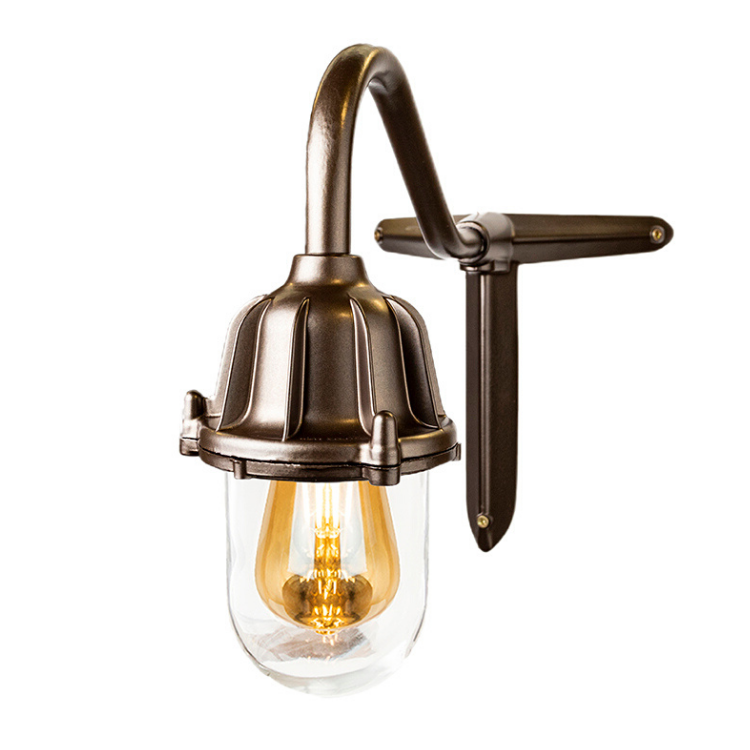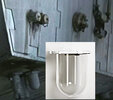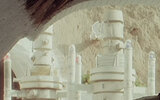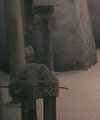So I recently bought a couple of Coughtrie lamps, and have posted about them. The topic has also come up here over the years, scattered across various threads. However, I thought it'd be useful to combine the known information about these things into a single post for reference purposes. Here it is.
Coughtrie is a small Scottish company, founded in 1939, that manufactures industrial and commercial lights. They're known for solid and weatherproof, if not particularly high-tech, lamps that basically consist of cast aluminium shells, ceramic bayonet British lamp sockets, and incandescent light bulbs. Their lamps are seen across the UK, often on the sides of old factories and housing estates. Nothing particularly glamorous. The firm still exists today.
One of their lamps, the SW10, was first made in the 1950s or so, and consists of a solid metal shell with fins for radiating the heat from a tungsten bulb, a rubber (formerly cork) gasket and metal retaining ring (rated IP65), a glass dome or "wellglass", grease-lubricated stainless steel screws to hold the base and ring together, and a curved swan neck metal conduit. Optional dish-shaped reflector. The base and ring are cast aluminium, usually enamelled with thick grey, white, or black paint to protect the metal from the weather and conceal the somewhat rough casting.

The lamp shown here was probably manufactured sometime in the 1990s, and is new old stock.

This lamp is still produced and sold today in 2020. The only difference, so far as I can tell, is that the drilled-out hole in the top changed at some point from a 3/4" hole (about 19mm) to a 20mm hole. The writing on the base may also have changed - current products read "COUGHTRIE GLASGOW REF S.W.10". Old lamps, frequently taken off demolished council buildings and whatnot, make their way to auction sites where they tend to command surprisingly high prices, considering the rough state they're often in. Regardless - these things are easy to find, and new and new old stock lamps are readily available in the UK. Sometimes you see people selling paint-stripped and polished-up lamps as kinda dieselpunky pendant lights for installing in pubs in Shoreditch, etc. I'm going to put one in my home office, in fact. Fun!
But this would all be of academic interest if it weren't for the fact that the base of this lamp found its way onto the Star Wars sets of 1976 at EMI Elstree.
MILLENNIUM FALCON SCONCES
The Falcon's corridors contain groups of wall sconces, and Coughtrie lamp bases were used as part of those lamps. The original Star Wars set had square gridded panels, backlit pale green, and a protruding Coughtrie base. It sort of doesn't make any sense, as the base doesn't produce any light and just sticks out, ready to bang someone in the head if the ship lurches. But it does look kind of cool.

For the Empire Strikes Back the corridors were rebuilt. Coughtrie bases were used again, but this time circular backlights were used. These make no sense from a story continuity perspective, as the original square holes are larger than the circles. But hey - so it goes. The panels were backlit pale blue. Interestingly the one below seems to be falling off its backlight ring.

The sequel films reproduce the ESB look of the Falcon, Coughtries and all. But, perhaps as a nod to the original film, the backlights were changed to a green colour.
The Coughtrie bases were all painted dark grey or maybe black. There were a lot of them required, and given British set builders' tendency to make plaster casts, I suspect that they didn't buy tons of old lamps, but made casts for them all. That is conjecture, however, and I have no evidence one way or the other for that.
THE WOOD-BURNING STOVE DROID
The rolling cylindrical droid in the sandcrawler, that looks rather like a wood-burning stove complete with chimney, has a single Coughtrie base on the front.

LARS HOMESTEAD AND MOS EISLEY STREET BOXES
Rows of Coughtrie bases can be seen on the chamfered box thingies that appear at the Lars homestead set in Tunisia.

At least one of the boxes was shipped to Djerba and can be seen in the back of the "these aren't the droids you're looking for" scene.

Finally three of these boxes appear in the Elstree-shot scene on the street outside the docking bay.

THE CANTINA
Facebook "Props of Star Wars: the Original Trilogy" member Kevin Brace points out that a pair of Coughtries appears to have been screwed together to make a wall greebly for the cantina set used in Elstree. However, it's barely visible in the finished film - just a detail in the long pan that opens the scene.


The reason you can't see the Coughtrie lamps behind Greedo in his showdown with Han Solo is because the seated Greedo takes (featuring Canadian Maria De Aragon) were all filmed in Los Angeles as pickup shots in 1977. Relatively little of the original English-filmed Greedo footage (featuring Briton Paul Blake) from 1976 was used in the final film. They thus didn't use the same set for the two Greedos, and there is a minor continuity error accordingly.
LUKE'S X-WING
A Coughtrie base seems to be installed in a round thing behind R2-D2 aboard Luke's X-wing.

MOISTURE VAPORATORS?
The moisture vaporator props had lamps on the top of the lower four posts. These resemble the glass domes used in Coughtrie lamps, though the ones below are painted white. However, the flange or lip looks a bit thicker to me than the should be for Coughtries, and they also seem a tiny bit too long and/or narrow. So I'd say they might be some Coughtrie variant, or perhaps some other company's glass dome/wellglass.

DOCKING BAY 94?
The walls of the docking bay had blinky lights. Coughtrie lamp domes were made in different colours such as red and blue. So it's possible that these are Coughtrie lamp domes. However the ones in the film look a bit squatter than the Coughtries. They also look tapered, whereas the Coughtries are closer to parallel. It's hard to say - perhaps it's just the angle from which we see them in the film.
So it's hard to say. Perhaps the docking bay wall lights were Coughtries; perhaps they were taken off Hella emergency beacons, like the two red ones on the blue box underneath the Falcon.

So, there we go. Obscure lamp base trivia!
Anyone else know of any other appearances of this greebly in the films?
Coughtrie is a small Scottish company, founded in 1939, that manufactures industrial and commercial lights. They're known for solid and weatherproof, if not particularly high-tech, lamps that basically consist of cast aluminium shells, ceramic bayonet British lamp sockets, and incandescent light bulbs. Their lamps are seen across the UK, often on the sides of old factories and housing estates. Nothing particularly glamorous. The firm still exists today.
One of their lamps, the SW10, was first made in the 1950s or so, and consists of a solid metal shell with fins for radiating the heat from a tungsten bulb, a rubber (formerly cork) gasket and metal retaining ring (rated IP65), a glass dome or "wellglass", grease-lubricated stainless steel screws to hold the base and ring together, and a curved swan neck metal conduit. Optional dish-shaped reflector. The base and ring are cast aluminium, usually enamelled with thick grey, white, or black paint to protect the metal from the weather and conceal the somewhat rough casting.
The lamp shown here was probably manufactured sometime in the 1990s, and is new old stock.
This lamp is still produced and sold today in 2020. The only difference, so far as I can tell, is that the drilled-out hole in the top changed at some point from a 3/4" hole (about 19mm) to a 20mm hole. The writing on the base may also have changed - current products read "COUGHTRIE GLASGOW REF S.W.10". Old lamps, frequently taken off demolished council buildings and whatnot, make their way to auction sites where they tend to command surprisingly high prices, considering the rough state they're often in. Regardless - these things are easy to find, and new and new old stock lamps are readily available in the UK. Sometimes you see people selling paint-stripped and polished-up lamps as kinda dieselpunky pendant lights for installing in pubs in Shoreditch, etc. I'm going to put one in my home office, in fact. Fun!
But this would all be of academic interest if it weren't for the fact that the base of this lamp found its way onto the Star Wars sets of 1976 at EMI Elstree.
MILLENNIUM FALCON SCONCES
The Falcon's corridors contain groups of wall sconces, and Coughtrie lamp bases were used as part of those lamps. The original Star Wars set had square gridded panels, backlit pale green, and a protruding Coughtrie base. It sort of doesn't make any sense, as the base doesn't produce any light and just sticks out, ready to bang someone in the head if the ship lurches. But it does look kind of cool.
For the Empire Strikes Back the corridors were rebuilt. Coughtrie bases were used again, but this time circular backlights were used. These make no sense from a story continuity perspective, as the original square holes are larger than the circles. But hey - so it goes. The panels were backlit pale blue. Interestingly the one below seems to be falling off its backlight ring.
The sequel films reproduce the ESB look of the Falcon, Coughtries and all. But, perhaps as a nod to the original film, the backlights were changed to a green colour.
The Coughtrie bases were all painted dark grey or maybe black. There were a lot of them required, and given British set builders' tendency to make plaster casts, I suspect that they didn't buy tons of old lamps, but made casts for them all. That is conjecture, however, and I have no evidence one way or the other for that.
THE WOOD-BURNING STOVE DROID
The rolling cylindrical droid in the sandcrawler, that looks rather like a wood-burning stove complete with chimney, has a single Coughtrie base on the front.
LARS HOMESTEAD AND MOS EISLEY STREET BOXES
Rows of Coughtrie bases can be seen on the chamfered box thingies that appear at the Lars homestead set in Tunisia.
At least one of the boxes was shipped to Djerba and can be seen in the back of the "these aren't the droids you're looking for" scene.
Finally three of these boxes appear in the Elstree-shot scene on the street outside the docking bay.
THE CANTINA
Facebook "Props of Star Wars: the Original Trilogy" member Kevin Brace points out that a pair of Coughtries appears to have been screwed together to make a wall greebly for the cantina set used in Elstree. However, it's barely visible in the finished film - just a detail in the long pan that opens the scene.
The reason you can't see the Coughtrie lamps behind Greedo in his showdown with Han Solo is because the seated Greedo takes (featuring Canadian Maria De Aragon) were all filmed in Los Angeles as pickup shots in 1977. Relatively little of the original English-filmed Greedo footage (featuring Briton Paul Blake) from 1976 was used in the final film. They thus didn't use the same set for the two Greedos, and there is a minor continuity error accordingly.
LUKE'S X-WING
A Coughtrie base seems to be installed in a round thing behind R2-D2 aboard Luke's X-wing.
MOISTURE VAPORATORS?
The moisture vaporator props had lamps on the top of the lower four posts. These resemble the glass domes used in Coughtrie lamps, though the ones below are painted white. However, the flange or lip looks a bit thicker to me than the should be for Coughtries, and they also seem a tiny bit too long and/or narrow. So I'd say they might be some Coughtrie variant, or perhaps some other company's glass dome/wellglass.
DOCKING BAY 94?
The walls of the docking bay had blinky lights. Coughtrie lamp domes were made in different colours such as red and blue. So it's possible that these are Coughtrie lamp domes. However the ones in the film look a bit squatter than the Coughtries. They also look tapered, whereas the Coughtries are closer to parallel. It's hard to say - perhaps it's just the angle from which we see them in the film.
So it's hard to say. Perhaps the docking bay wall lights were Coughtries; perhaps they were taken off Hella emergency beacons, like the two red ones on the blue box underneath the Falcon.
So, there we go. Obscure lamp base trivia!
Anyone else know of any other appearances of this greebly in the films?
Last edited:






